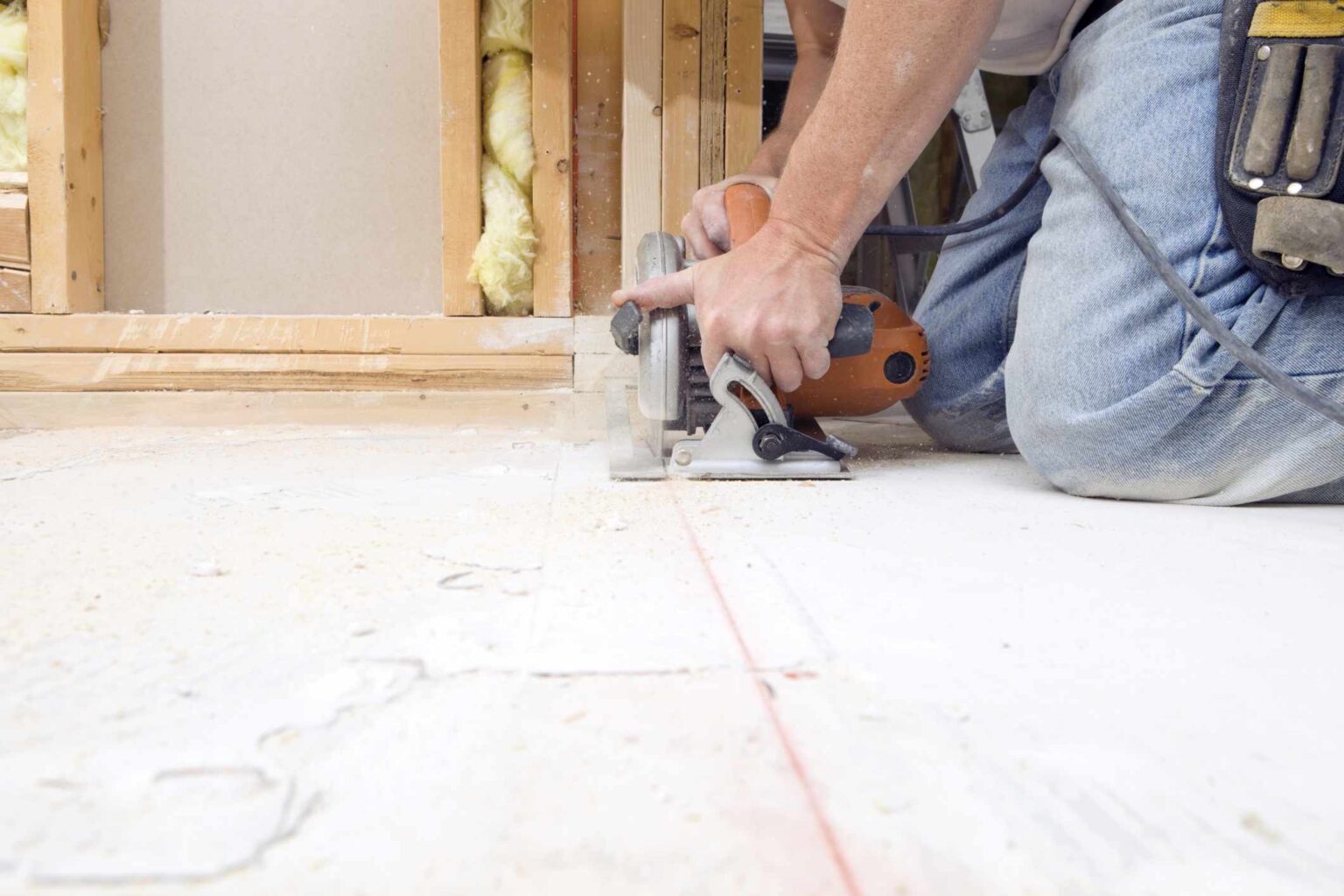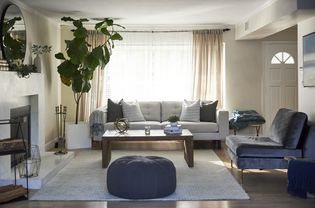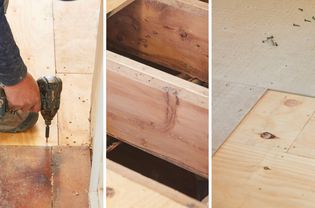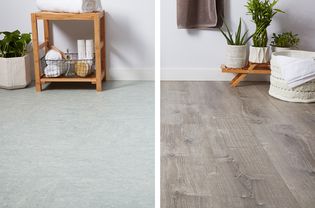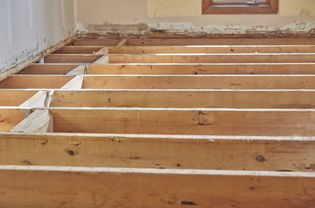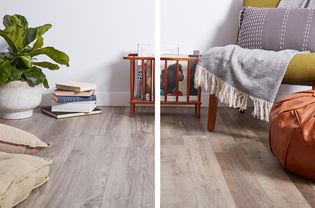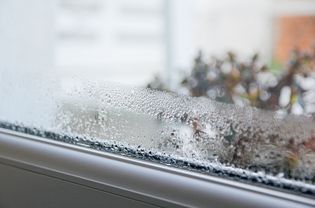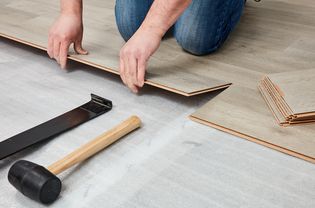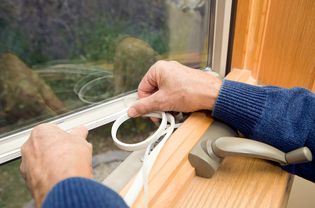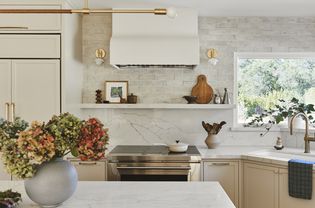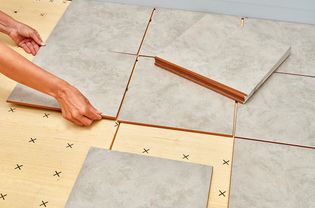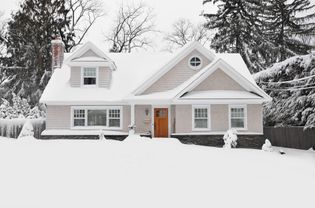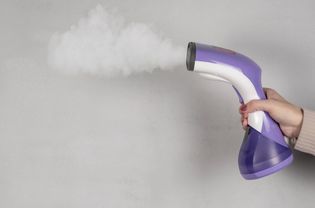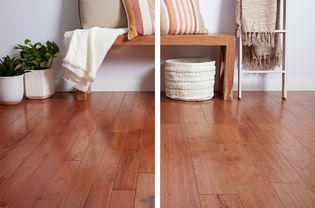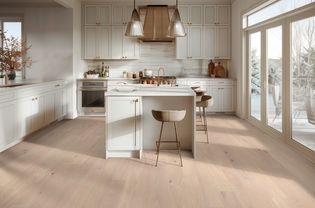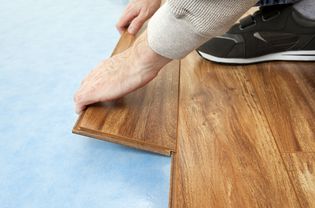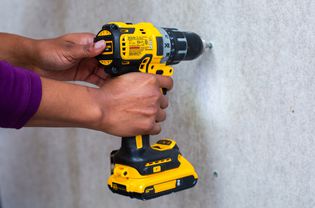Act as an expert content writer specialized in Interior Walls and Ceilings design, who speaks and writes fluently in French. Translate the article below into French. Continue writing until you finish translating the entire content from beginning to the end. Make sure the translation is linguistically accurate, and conveying the meaning, facts and figures of the original text. Make sure the content generated is well written and does not sound like a translation and reflects an awareness of the culture of French people. Don’t talk about Yourself or Your Experience. Don’t Self-reference. Don’t explain what you are doing. Write the content in HTML format and Keep the images and the structure of the article as they originally are. The article to translate:
A typical wood-framed residential flooring system is more complicated than you think. In addition to the visible surface flooring material—the carpet, tile, or hardwood—there is usually an underlayment, and beneath that is a subfloor that serves as the foundation and structural reinforcement for the floor. The subfloor consists of sheet materials that are nailed or screwed to the joists to form the base for the underlayment and surface flooring material. The terms « underlayment » and « subfloor » are often used interchangeably, but they are separate layers. The subfloor is always a structural layer of sheet good material—usually plywood, oriented strand board (OSB), or occasionally particleboard.
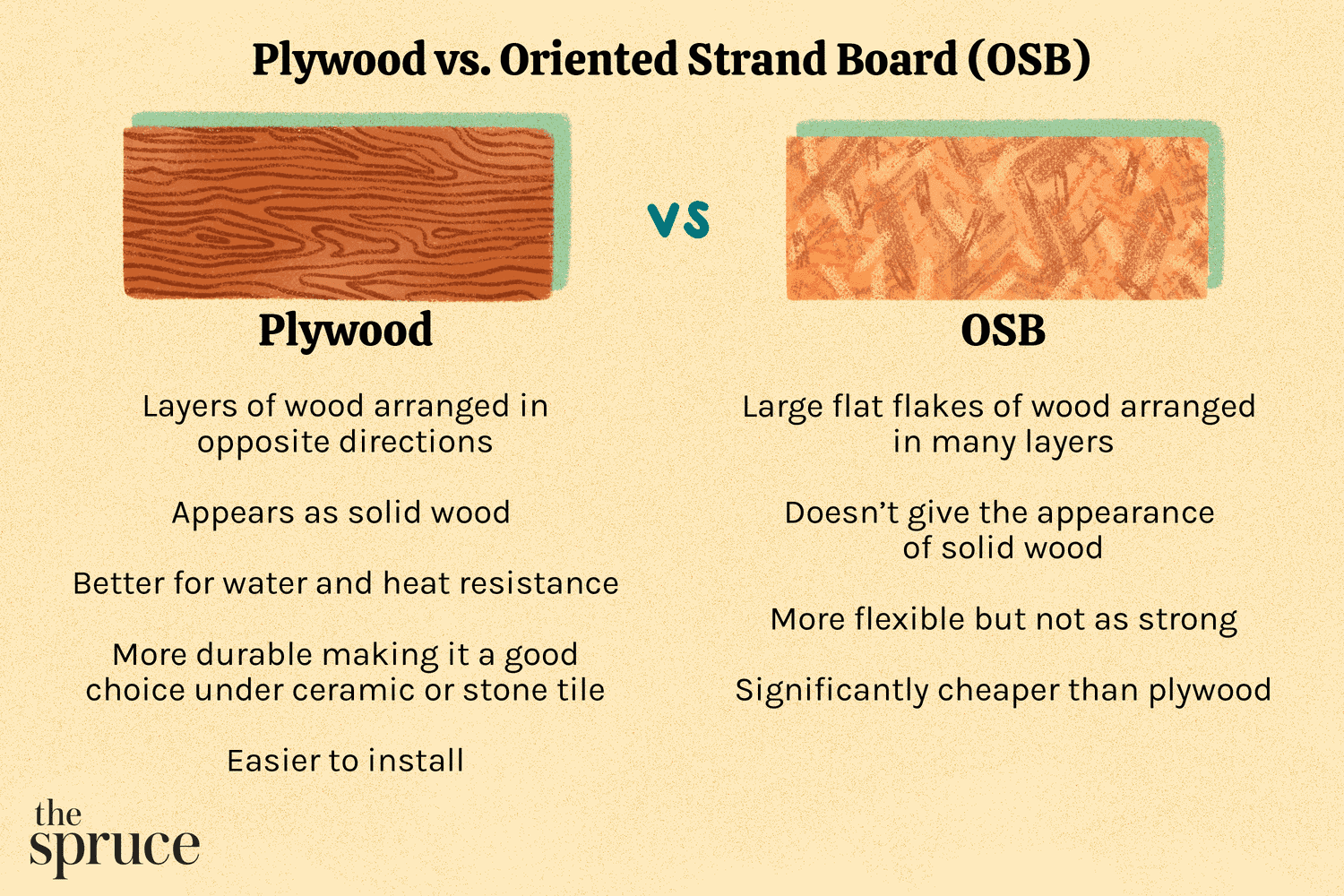
The Spruce / Madelyn Goodnight
Builders often debate which is best for the two most common subfloor materials: plywood or OSB. Familiar to most people, plywood is a sheet material made from layers of wood oriented in opposite directions from layer to layer.
OSB (oriented strand board) is a different form of sheet material. While the name may be unfamiliar, you probably recognize this material. OSB sometimes called « chipboard, » is composed of large flat flakes of wood arranged in many layers and sealed together with phenolic resins to make sheets. Since it’s less expensive than plywood, OSB is often favored by builders when covering a lot of space.
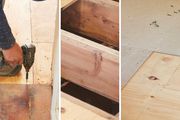
Plywood vs. OSB (Oriented Strand Board): Major Differences
A plywood subfloor generally uses 1/2-inch to 3/4-inch-thick sheets of plywood with one rough side (which faces down) and one smooth side, which faces up. The sheets are typically 4 by 8 or 4 by 12 feet in size. Plywood is made by gluing together multiple thin layers of solid wood at 90-degree angles and pressing them tightly as the glue dries to form a strong structural sheet. In the 1950s, this material quickly replaced solid wood planking as a home subfloor material.
You can use standard plywood for subfloors, but it is more common to use tongue-and-groove sheets that interlock along the edges. The spacing of the joists governs the recommended thickness of the plywood subfloor. Some experts suggest that 15/32-inch plywood should be standard if the underlying floor joists are spaced 16 inches apart or less, but you should use slightly thicker 3/4-inch plywood for joists spaced further apart. However, check with your local code authorities for the official recommendations.
OSB (oriented strand board) is made from large, flat chips arranged in as many as 50 layers, which are adhered together with glues and pressed into sheets. Because it uses leftover wood material, OSB tends to be cheaper than plywood, and it is more uniform since it has none of the knots and other defects that may be present in plywood. OSB came into use as a subfloor material in the 1970s.
The type of OSB used for subfloors generally is made with tongue-and-groove edges (T & G). The standard subfloor for joists spaced up to 16 inches apart is 23/32-inch T & G sheets. Some local codes may require 1-inch thick sheets for joists up to 24 inches apart; for these, you may need to buy from a construction lumber yard since general home-improvement centers may not stock them.
When looking at the attic or shed flooring, look at a subfloor’s horizontal shear strength. OSB has twice the horizontal shear strength of plywood. It’s a better option than plywood for subflooring in attics and sheds. Also, OSB panels can be an advantage when flooring a big or odd-size shed, reducing the number of joints on a floor. However, one of the biggest disadvantages of OSB is how its edges swell when exposed to water, significantly more than plywood. So, if your shed is prone to dampness and moisture, plywood might be more durable.
| Plywood | OSB Subfloor | |
| Structural Strength | Stronger, more rigid | Slightly weaker |
| Moisture Resistance | Usually does not swell when wet | Edges, in particular, swell if they get wet |
| Suitablity for Flooring Materials | Suitable for all flooring | Avoid with ceramic or stone tile |
| Cost | About $21 per 4 x 8 sheet | About $16 per 4 x 8 sheet |
| Nail/Screw Holding Power | Better holding power | Less holding power |
| Installation Details | Nails or screws driven along seams and through the field | Nails and screws along seams and through the field; may require more fasteners |
| Sizes | 4 x 8 or 4 x 12-foot sheets | 4 x 8 or 4 x 12-foot sheets |
Appearance
Plywood
Plywood is made from several layers of wood veneer glued together at alternating right angles. The layers will be clearly visible when the sheets are viewed from the edge, but when viewed from above the surface veneer makes the sheet look like solid wood.
OSB
Oriented strand board has many flat wood chips glued up together in a solid sheet. These flat chips are clearly visible when the sheet is viewed from above, and it is clear that OSB is not a sheet of solid wood.
Best for Appearance: Tie
Since the subfloor is entirely hidden, neither material is visible, except from the unfinished space beneath the floor.
Water and Heat Resistance
Plywood
Plywood has a slightly greater capacity for absorbing water, but it also dries out faster. Overall, plywood is more resistant to permanent swelling.
OSB
OSB is slightly more resistant to water, but it tends to absorb and hold it longer once it gets wet. OSB has untreated edges that are somewhat more susceptible to swelling if they get wet. Serious spills and flooding should be remedied as soon as possible.
Best for Water and Heat Resistance: Plywood
Plywood is more likely to resist permanent swelling, which is a good quality for a subfloor material, keeping the flooring even. Both plywood and OSB will burn should a house fire break out.
Care and Cleaning
Plywood
No care and cleaning necessary; this is a hidden building material.
OSB
No care and cleaning necessary; this is a hidden building material.
Best for Care and Cleaning: Tie
As a hidden building material, there is no routine care and cleaning for either plywood or OSB underlayment. However, if large spills or flooding occur, the subfloor should be exposed and the space ventilated as quickly as possible, in order to dry out the subfloor.
Durability and Maintenance
Plywood
A well-installed subfloor should last as long as the house itself. Because plywood is inherently a stiffer material with greater strength, it is a better choice as a subfloor under ceramic or stone tile.
OSB
A well-installed subfloor should last as long as the house itself, but OSB is slightly more flexible than plywood, so it is not the best choice under heavy flooring like ceramic or stone tile.
Best for Durability and Maintenance: Plywood
As subfloor materials, both plywood and OSB should last as long as the house itself if the subfloor has been properly installed. There is no maintenance required, except to keep the subfloor as dry as possible. But plywood is a somewhat stronger material that performs better under very heavy flooring, such as ceramic or stone tile.
Installation
Both subfloor materials are installed the same way. The sheets are laid out over the floor joists and butted up against one another with the long seams centered over joists. End joints should be offset from row to row so they don’t line up. The sheets are anchored to the joists with nails or screws driven 6 inches apart, and they are secured to joists across the « field » of each sheet with screws or nails driven every 8 inches. Many installers apply a bead of construction adhesive across each joist before laying the subfloor sheets down.
Plywood
Construction crews tend to prefer plywood because it is easier to install and makes for a somewhat more secure and stronger subfloor.
OSB
Because OSB has slightly less holding power for screws and nails, some builders like to space fasteners closer than they do with plywood.
Best for Installation: Plywood
OSB is a heavier, more brittle material than plywood, and it has slightly less holding power for nails and screws. Where the panels are glued down, OSB also has slightly less holding power with construction adhesives.
Cost
Plywood
A 4 x 8-foot sheet of 3/4-inch-thick subfloor-grade plywood sells for about $21.50 at home improvement centers.
OSB
OSB costs $3 to $5 less per panel when compared to plywood, so the cost savings when building an entire house is significant. At a major home improvement center, a 4 x 8-foot sheet of 23/32-inch OSB costs about $16.50,
Best for Cost: OSB
OSB costs significantly less than plywood subfloor sheets.
Lifespan
Plywood
Plywood subfloors should last as long as the house itself.
OSB
Like plywood, OSB subfloors should last as long as the house itself.
Best for Lifespan: Tie
Both OSB and plywood subfloors can be expected to last for the life of the house, if they are properly installed and kept dry.
Sizes
Plywood
Plywood is available in the same sizes as OSB.
OSB
OSB comes in the same sizes as plywood subfloor sheets.
Best for Sizes: Tie
Subfloor sheets for both OSB and plywood come in 4 by 8 or 4 by 12 sheets. Thicknesses for products used for subfloors are generally 23/32 inch (just under 3/4 inch), but thicker sheets are available where building codes call for them.
Comfort and Sound
Plywood
Plywood is roughly 10 percent stiffer over the span between joists, so it may flex less underfoot than OSB. However, very few people are able to recognize this.
OSB
As a slightly more flexible material, OSB may flex underfoot when installed under carpet or sheet vinyl, but it is almost never noticed with ceramic tile or wood flooring.
Comfort and Sound: Tie
There is usually no appreciable difference in the performance characteristics of plywood or OSB subfloors. Under some circumstances, OSB may flex underfoot when installed under carpet or vinyl flooring; this usually occurs if joist spacing is a wide 24 inches rather than the standard 16 inches.
Resale Value
Plywood
Because plywood is the stronger material, very observant home buyers may place a small premium on plywood subfloors.
OSB
Rarely, a prospective homeowner may recognize that OSB is the cheaper subfloor material.
Best for Resale Value: Plywood
Although it’s very unlikely that the subfloor material will be noticed, a plywood subfloor may be preferred by a few prospective homeowners.
The Verdict
Costs aside, plywood is still rightly considered a slightly superior material to use as a subfloor, thanks to its superior structural strength. However, the difference is not very significant, and the cost-saving offered by OSB makes it a perfectly acceptable subfloor material in most situations.




